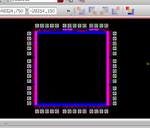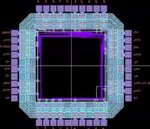bio_man
Full Member level 2
hi,
I am using CN05 Technology and I got PadFrame (attached) from a friend who used to layout digital IC. For my IC, I have Comparators on-board. My questions:
1) Should I care too much about the Pad type ( digital vs. analog)?
2) The PadFrame I got looks very simple not like others I saw in Literature (example of a Pad is also attached), Is it OK?
3) For one input to my circuit, I want to sense a small voltage (0.3-0.5 V) that comes from an off-chip solar cell, is it ok to ignore the ESD protection for this Pad? because I dont't want the ESD circuit to distort this small voltage signal.
4) Can you please advise how can I check the acceptable thickness of my traces that can handle current of the circuit?
Thanks all
- - - Updated - - -
Update: my circuit contains a ring oscillator that generates 500kHz internally
I am using CN05 Technology and I got PadFrame (attached) from a friend who used to layout digital IC. For my IC, I have Comparators on-board. My questions:
1) Should I care too much about the Pad type ( digital vs. analog)?
2) The PadFrame I got looks very simple not like others I saw in Literature (example of a Pad is also attached), Is it OK?
3) For one input to my circuit, I want to sense a small voltage (0.3-0.5 V) that comes from an off-chip solar cell, is it ok to ignore the ESD protection for this Pad? because I dont't want the ESD circuit to distort this small voltage signal.
4) Can you please advise how can I check the acceptable thickness of my traces that can handle current of the circuit?
Thanks all
- - - Updated - - -
Update: my circuit contains a ring oscillator that generates 500kHz internally

